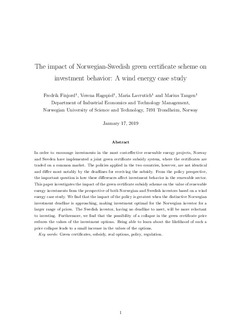| dc.contributor.author | Finjord, Fredrik | |
| dc.contributor.author | Hagspiel, Verena | |
| dc.contributor.author | Lavrutich, Maria | |
| dc.contributor.author | Tangen, Marius | |
| dc.date.accessioned | 2019-02-25T10:11:42Z | |
| dc.date.available | 2019-02-25T10:11:42Z | |
| dc.date.created | 2018-09-21T14:09:55Z | |
| dc.date.issued | 2018 | |
| dc.identifier.citation | Energy Policy. 2018, 123 373-389. | nb_NO |
| dc.identifier.issn | 0301-4215 | |
| dc.identifier.uri | http://hdl.handle.net/11250/2587182 | |
| dc.description.abstract | In order to encourage investments in the most cost-effective renewable energy projects, Norway and Sweden have implemented a joint green certificate subsidy system, where the certificates are traded on a common market. The policies applied in the two countries, however, are not identical and differ most notably by the deadlines for receiving the subsidy. From the policy perspective, the important question is how these differences affect investment behavior in the renewable sector. This paper investigates the impact of the green certificate subsidy scheme on the value of renewable energy investments from the perspective of both Norwegian and Swedish investors based on a wind energy case study. We find that the impact of the policy is greatest when the distinctive Norwegian investment deadline is approaching, making investment optimal for the Norwegian investor for a larger range of prices. The Swedish investor, having no deadline to meet, will be more reluctant to investing. Furthermore, we find that the possibility of a collapse in the green certificate price reduces the values of the investment options. Being able to learn about the likelihood of such a price collapse leads to a small increase in the values of the options. | nb_NO |
| dc.language.iso | eng | nb_NO |
| dc.publisher | Elsevier | nb_NO |
| dc.rights | Attribution-NonCommercial-NoDerivatives 4.0 Internasjonal | * |
| dc.rights.uri | http://creativecommons.org/licenses/by-nc-nd/4.0/deed.no | * |
| dc.title | The impact of Norwegian-Swedish green certificate scheme on investment behavior: A wind energy case study | nb_NO |
| dc.type | Journal article | nb_NO |
| dc.type | Peer reviewed | nb_NO |
| dc.description.version | acceptedVersion | nb_NO |
| dc.source.pagenumber | 373-389 | nb_NO |
| dc.source.volume | 123 | nb_NO |
| dc.source.journal | Energy Policy | nb_NO |
| dc.identifier.doi | 10.1016/j.enpol.2018.09.004 | |
| dc.identifier.cristin | 1612163 | |
| dc.relation.project | Norges forskningsråd: 268093 | nb_NO |
| dc.description.localcode | © 2018. This is the authors’ accepted and refereed manuscript to the article. Locked until 17.09.2020 due to copyright restrictions. This manuscript version is made available under the CC-BY-NC-ND 4.0 license http://creativecommons.org/licenses/by-nc-nd/4.0/ | nb_NO |
| cristin.unitcode | 194,60,25,0 | |
| cristin.unitname | Institutt for industriell økonomi og teknologiledelse | |
| cristin.ispublished | true | |
| cristin.fulltext | postprint | |
| cristin.qualitycode | 1 | |

